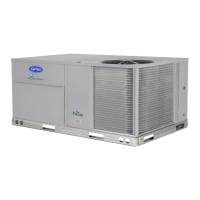171
Gas System Adjustment (48N Only)
TWO-STAGE GAS VALVE ADJUSTMENT — The gas
valve opens and closes in response to the unit control.
When power is supplied to valve terminals D1 and C2, the
main valve opens to its preset position.
The regular factory setting is stamped on the valve body
(3.3 in. wg).
To adjust regulator:
1. Set thermostat at setting for no call for heat.
2. Switch main gas valve to OFF position.
3. Remove
1
/
8
-in. pipe plug from manifold or gas valve
pressure tap connection. Install a suitable pressure-
measuring device.
4. Switch main gas valve to ON position.
5. Set thermostat at setting to call for heat.
6. Remove screw cap covering regulator adjustment
high-fire screw (see Fig. 80).
7. Turn adjustment screw clockwise to increase pressure
or counterclockwise to decrease pressure.
8. Once desired pressure is established, set thermostat
setting for no call for heat, turn off main gas valve,
remove pressure-measuring device, and replace
1
/
8
-in.
pipe plug and screw cap.
MODULATING GAS VALVE ADJUSTMENT — The
modulating gas valve is an electrically operated valve con-
trolled by a 0 to 20 vdc input directly to valve terminals or from
an external controller. The modulating gas valve is installed
downstream from a separate pressure regulator, such as a 2-
stage gas valve. See Fig 81.
The modulating gas valve has both sides fitted for low fire
adjustment. When 0 vdc is applied at the connect terminals, the
bypass provides a minimum outlet pressure of 0.3 in. wg for
2.0 in. wg at the gas regulator upstream the modulating valve
(factory setting).
For low fire adjustment (see Fig. 82):
1. Disconnect a wire from modulating valve connect termi-
nals.
NOTE: Do not allow wire to come into contact with any
other part.
2. Remove the left bypass cap.
3. Turn adjustment screw using a small screwdriver to the
desired low fire adjustment.
NOTE: Clockwise screw rotation reduces flow rate. Do
not over tighten.
MAIN BURNERS — For all applications, main burners are
factory set and should require no adjustment.
MAIN BURNER REMOVAL AND REPLACEMENT
1. Shut off (field-supplied) manual main gas valve.
2. Shut off power to unit.
3. Remove gas section access door, door frame, and corner
post.
4. Disconnect gas piping from gas valve inlet.
5. Remove wires from gas valve.
6. Remove wires from rollout switch.
7. Remove sensor wire and ignitor cable form IGC board.
8. Remove 2 screws securing manifold bracket to basepan.
9. Remove 2 screws that hold the burner support plate
flange to the vestibule plate.
10. Lift burner assembly out of unit.
11. Replace burner assembly. Reinstall by reversing Steps 1
to 10.
Moisture/Liquid Indicator — A clear flow of liquid
refrigerant indicates sufficient charge in the system. Bubbles
indicate undercharged system or the presence of noncondens-
ables. Moisture in the system measured in parts per million
(ppm) changes the color of the indicator:
Green — moisture below 45 ppm (dry)
Chartreuse — 45 to 130 ppm (caution!)
Yellow — moisture above 130 ppm (wet)
Change filter driers at the first sign of moisture in the sys-
tem. See Carrier Charging Handbook for more information.
IMPORTANT: Unit must be in operation at least
12 hours before moisture indicator can give an accurate
reading. With unit running, indicating element must be
in contact with liquid refrigerant to give a true reading.
INLET PRESSURE
TAP (ON SIDE)
1/8-IN. 27 NPT
OUTLET PRESSURE
TAP (ON SIDE)
1/8-IN. 27 NPT
HIGH-FIRE REGULATOR
ADJUSTMENT SCREW
LOW-FIRE REGULATOR
ADJUSTMENT SCREW
Fig. 80 —Two-Stage Gas Valve
2-STAG E
GAS VALVE
MODULATING
GAS VALVE
Fig. 81 — Modulating Gas Valve Location
a48-8595
TERMINALS
RIGHT
BYPASS
CAP
LEFT
BYPASS
CAP
LEFT
ADJUSTMENT
SCREW
(HIDDEN)
RIGHT
ADJUSTMENT
SCREW
(HIDDEN)
Fig. 82 — Modulating Gas Valve Bypass
Adjustment
a48-8596

